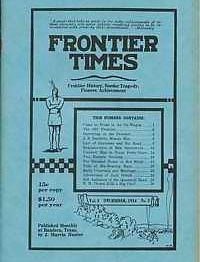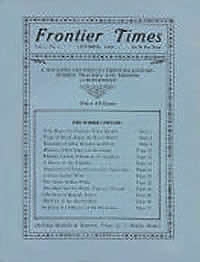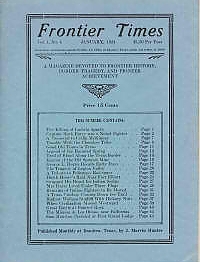By using our website, you agree to the use of cookies as described in our Cookie Policy
Magazines & Instant Downloads
Vol 02 No. 03 - December 1924
Came to Texas in an Ox-Wagon
Mrs. Florence Lanham, Nimrod, TX. Jane Wetherby Ferguson was born in Lawrence county -.Mississippi. October 25, 1835, . At the close of the Civil War she was the mother of five children, and came to TX with her father’s family in 1867, and eventually settled in Comanche county. She was a true pioneer mother, having gone from a life of relative ease in her former state to the hardships of life in the TX frontier – this is her story.
The old Frontier; Events of Long Ago
W. K. Baylor. Jack county was scene of some of the most brutal of Indian attacks in pioneer days. In June, 1871, Charles E. Rivers was killed by the Indians in Jack county while gathering cattle. He was a native of Louisiana. His father came to Texas when Charley was a small boy. This is the account of the events leading up to and during the attack that left this good man dead.
Further Mentions: Todd Willett, Weatherford in Parker county, he married Mrs. Ford, who was a daughter of that noble old frontiersman and princely gentleman, Oliver Loving, W. B. Slaughter, who heard the shots and yells of the Indians when the camp of Charley Rivers was attacked, Salt Creek in Young county, Dillingham Prairie, in Jack county, Rock Creek, Little Lost Valley, Dr. Millikin
Surveying on the Frontier of Texas
B. Gillett, Ex Sargeant, Texas Rangers. Gillett, when only a boy of 14 accompanied 5 others on a lenthy, lonely and dangerous expedition to survey the parts of the TX frontier now known as Coleman county and those parts around Camp Colorado, Santa Anna, Post Oak Springs, Ballinger, Buffalo Gap, Table Mountain, etc. The writer recounts notable experiences including an Indian raid on the Heart Ranch, on Jim Ned Creek.
Further Mentions: Jake Lutz and Dave Ligon, Tom Merrill, Bagdad in Williamson. County, Liberty Hill, Brownwood, Texas, the Connolleys, the Fisks, the Adamses, and the Vaughns, My father employed a scout by the name of Alexander as guide., the Heart ranch, in the northern part of Coleman County, Cape Willingham from Georgia, Maj. Hines, Rufe Evans, all from the state of Georgia and quite green as to frontier life, the Turkey Track ranch
J. S. Burdette, Minute Man and Soldier
Odie Minatra, Corsicana, Texas. Very interesting account of Mr. and Mrs. J. S. Burdette, living in Dawson, Texas. Mr. Burdette was born in 1844, in Shelby county, His father moved to Johnson county before the catastrophe of 1861. Here young John Burdette ranged and hunted over the bald prairie and "cow licks" where now is the thriving little city of Cleburne. Buchanan was then the county seat. As a boy in his early teens he rode with a "Minute Company" organized at old Alvarado with Cathey in command. These companies were formed for the purpose of domestic protection while the able-bodied adult men were off serving the Confederacy during the Civil War. With this company Burdette saw thrills unbelievable to the modern youth. His compatriots for the most part were no more than fourteen to sixteen years of age, but all skilled in horsemanship and the use of weapons. The Cherokees and others took advantage of the absence of the men to make forays on the settlers. Young Burdette early had an encounter while out scouting with Captain Cathey. In the Hills beyond what is now Ft. Worth, but what was then only a log commissionary, three Indians armed and well mounted were seen. Cathey and Burdette maneuvered for advantage. Finally Captain Cathey told his youthful scout to ascend the head of the canyon and thus intercept their escape while he at the right moment would push in from the rear. "Give me your horse," he said, a fleet footed part Arabian, which Burdette proudly owned. "I'll get them, while you engage them in the front." A few moments and the supposed warriors saw a lone horseman pursuing them. A running fight ensued in which superior speed and marksmanship prevailed, and three Indian ponies galloped over the plain riderless...
Further Mentions: In Davidson's brigade, known as the "Dirty Devils," he took part in the notable Peach Orchard Fight where 2800 Texans held nearly ten times their number in stubborn and victorius skirmish., As soon as he could pass physical muster Burdette was with the Confederates in Louisiana, "I soldiered here with the laziest and gamest man in the war," "Hugh Taylor", the Cheneyville fight., Big Cain Louisiana, Sim Dickson, the Missouri crusader, Merrit Trammel, negro deputy sheriff, Old Harcrow, Pat Plummer whose mother was captured by the Indians
HANGING OF BILL LONGLEY.
Hiram C. Craig of Brenham. Eye-witness details to the event of Bill Longley’s notable death by hanging on October llth, 1878, near Giddings in Lee County Texas. Longley murdered Wilson Anderson at his home on the Yeagua Creek.
Further Mentions: Jim Brown, Sheriff of Lee co, Garfield Park in Chicago, two deputies, W. J. McClellan, Charlie Brown, Virge Woolley, Zinna Eggleston
The Last of Geronimo and His Band
Col. Win. Strover. Details the expedition into the frontier wilds of Arizona to sieze the half-breed Apache leader and his viscous band in 1885. The expedition to capture Geronimo was frought with numerous difficulties, among which were the dry conditions under which they labored while on the hunt. The years 1885 and 1886 were the driest years ever known in the territories. For nearly 13 months not a drop of rain had fallen in the territory of Arizona. Water holes and small streams which always had contained a fair supply of water had dried up, and troops were often forced to make long, heart-breaking rnarches between water places, and then to find only scant supplies. The cavalry, which was used to keep the Indians moving, was handicapped by having horses, which had to be watered and fed regularly, and which could not proceed headlong after Indians where water and feed were not certainly obtainable. The Indians who rode the wiry little ponies, inured to hardship and had always spare horses with them for a change, had an overwhelming advantage over the soldiers. Besides, they knew of hidden water holes unknown to the scout or soldier. Often, when in close proximity of fleeing Indians, the troops had to abandon the chase because the animals were on the verge of a breakdown. Furthermore, the heat was terriffic during the day. The soil, where it was not stony, was a pulverized dust, which rose in a straight column into the air when disturbed. During the hot season it was practically impossible to move in the daytime, and troops on the move would usually start the day's march before 4 in the morning, travel until near 1 o'clock, then lie around in the scant shade of cactus or mesquite until about 5:00. The march would be resumed and kept up until near 10 o' clock.. Lately there has been much written about the "cooties" in the trenches, and what a disgusting pest they were. Let the reader imagine the state of the soldier's body who had to live under the conditions told in this story, with water for washing only rarely available. They had a way to get rid of the "cooties" though. When we happened to rest at a place where shade was available, so that the sun would not blister the bare body, the soldier would strip off his underwear and shirt, go to a nearby ant hill, stir up the pile, so as to get the ants excited and then put his belongings on the ant hill. The ants, especially the large red kind, riled up over the disturbance, would attack the " cooties, " brood and all, and in a short while the pest had been exterminated. This intersting story goes on to detail the deportation of the Indians to far-away Florida in cattle-cars under the most horrendous conditions. The climate of Florida did not agree with them, though and they were later sent to Oklahoma, where their leader Geronimo, died some years later. During the last year of his life he was teaching a Sunday school class, and preaching salvation to his former bloodthirsty followers.
Reminiscences of Mrs. J. J. Greenwood
Mrs. A. D. Gentry, Fort Stockton. Story of a great pioneer woman of Lampasas. She came from her native Ireland in 1853, landing in New Orleans, where her mother died from yellow fever and left her an orphan in the care of Reverend Thomas Bacon, an Episcopal minister. She became an accomplished seamstress and gained notoriety in the production of Confederate uniforms and other paraphernalia. After the war she married J. J. Greenwood and the couple settled in Lampasas where she embraced the full range of life as a great Texas pioneer.
Further Mentions: the boat "Swamp Fox", "The Black Warrior," "The Magnolia," and "The Island City," Capt. Wm Hutchins of Belton
AFTER FIFTY-TWO YEARS.
Brief account of Mrs. T. M. Muse, resident of McKinney, who made a return trip to Waco after an absence of fifty-two years. She compares the Waco of 1862 to the Waco of 1924, comparing and describing the amazing changes.
Crockett Man is Texas "Forty-Niner"
By W. S. Adair. Story of N. B. Barbee of Crockett, father of N. B. Barbee of Dallas, who was a resident of Houston county since 1849. " Barbee was born in Tennessee in 1837, and his father, Dr. James E. Barbee, moved to Texas in 1841. He settled in Shelby county, where he figured as one of the Regulators in 1843. He went to the Mexican War as a physican and surgeon in 1846; the men in the home company agreeing to pay him each $3 a month to look after their health. This was in addition to his regular pay as an army surgeon. He was at school at Wesleyan College at San Augustine when Texas was annexed, and remembers the ceremonies of pulling down the Lone Star flag that floated over the main building and of replacing it with the Stars and Stripes. This is great early history of Crockett area.
Further Mentions: Hau's Bluff on the Trinity River, the Great Indian hunter Elisha Clapp and Houston Beeson, early Crockett residents. Company E, Gould's Battalion, Walker's Division., Jenkins' Ferry and Pleasant Hill., General Banks and the army of Gen. Steele
TWO HISTORIC SECTIONS
It is a somewhat remarkable fact that a very large majority of the men whose names are most conspicuous in the annals of Texas history should have been residents and natives of two sections of the state-East Texas and South Texas, Brazoria county in particular. The story then goes on to list an amazing list of the names of great men from these sections.
Just a partial example: Sam Houston, J. Pinkney Henderson, George T. Wood, Louis T. Wigfall, 0. M. Roberts, T. J. Jenniings, W. B. Ochiltree, F. B. Sexton, Frank W. Bowden, John H. Reagan, R. B. Htibbard, James S. Hogg, John L. Henry, T. R. Blount, Horace Chilton, Stephen F. Austin, Guy M. Bryan, The Bryan and Perry families, Thomas M. Jack, Andrew P. McCormic and James H. Bell, Elisha M. Pease, John A. Wharton, The Masterson family
The Haunted House on Red River
W. E. Payne. Account of the old Dock Carter mansion in Grayson County, in Red River bottom, about 12 miles from Denison. When W. E. Payne purchased the house and moved in, he was surprised to see the house was filled with beds, trunks, costly mirrors, and bookcases filled with works of standard English and American authors. Everything seemed to be left very much as when the place had been inhabited by Dock Carter and his family. As to why the house was left in this condition and had not been pilfered or vandalized, the local citizens and especially the Indians were assured that it was due the ghost of the deceased Dock Carter who came and visited the place each evening. Eventually Payne discovered the real reason though – a band of horse thieves had been using the place as a hideout, and so the true story begins. What follows is some very excellent early Grayson co. history.
Further Mentions: a young man named Larkin, the Chickasaw Nation, the euphonious name of "Thief Neck", notorious outlaws Lee Langford and his cousin, Thede De Graffenreid, Wolf City., Carpenters Bluff, Lem Reynolds, John Mashburn, sheriff of Panola County., Bud Kemp, Jim McLaughlin and Dave Kemp, Choctaw Bell, Wilbur, Mack Stephens, Walnut Grove, .Big Blue, a white man named Dodd, who had a Chocktaw family.
Old Timer Tells of Rip-Roaring Days.
George D. Dacy. Interesting story of the large impact that deadly snakes, particularly diamond-back rattlers had on the frontier of TX, AZ and New Mexico. Mentions many accounts of death and affliction from these predators and how bites were handled.
Further Mentions: Will C. Barnes, Mr. G. W. James, etc.
Early Courtship and Marriage in Texas
Newton C. Duncan of Wheellock, Texas. Account of how it was done in frontier days! Relationships were usually formed at the corner of the cow pen. ‘Ol Sam didn’t want to hitch the widder (widow) Mrs. Sikes, but rather sweet, young Lizzie.
From the story:
"Well, why didn’t you take the widder, Sam?" asked Lizzie.
"Wa’al I had some serious objections," said Sam.
"What are they?" inquired Lizzie.
"Wa’al I found on close examination she had lost an eye: then she’s red-headed, roman-nosed, and worse than all, she smokes a gourd-neck pipe that will hold half a plug of tobacco, and I have always had a horror of bein burnt"
The Adventures of Jack Dobell
By J. C. Duval.
SECOND INSTALLMENT. Very exciting and well-written account of bravery and soldier’s life in the Mexican War.
Bill Anderson of the Quantrell Band
Henry C. Fuller. One of Brown County's most interesting pioneers, is that of Col. William "Bill" C. Anderson. Known as "Bloody Bill Anderson," he was born February 7, 1840 in Missouri; died in Brown County, November 1, 1927. "Bloody Bill," was a member of the famous Quantrell guerrillas. He settled in the Salt Creek community in 1863. The log house where he lived is still standing near the Brownwood Regional Airport. This is his story.
E. M. Phelan Kills a Big Indian Chief
A.J. Sowell. In the spring of 1870 the Indians made a raid into Llano county and stole some horses from cowhunters who were camped on Sandies Creek and the cow boys at once sent a runner to a settlement on Pecan bayou, telling the people there to look out for the Indians as they were headed in that direction. Soon a band of 12 local settlers assembled, gathering in the night, and early next morning set out to see what signs of the Indians they could find. The names of this band of young Indian fighters were as follows: John Bachs, Gum Phillips, E. Phillips, E. M. Phelan, Sant Bacus, John Reams, Ralph Haynes, Eli Sheeley, Ben Gibson, James Harrington, Deeve Harrington, Ross Daniels and James Daniels.
The first thing they did was to proceed to a high ridge known as Mesquite Hill, which they ascended. There they watched until noon, as the Indians, during a raid in this part of the country generally passed near this place -either coming in or going out, but as no signs of them could he seen up to this time the boys concluded they had passed another way and left this elevated lookout and went into a chain of mountains on the headwater-, 6f Cypress creek, in Blanco county, about twelve miles north of Johnson City and thirty-five miles east of Fredericksburg. Here the trail of the Indians was found and also about that time a heavy rain set in, but this latter fact was to the advantage of the settlers, as they could follow the trail rapidly, sometimes at a gallop where the horses of the Indians sank deeply in the soft earth.
Several miles were passed over in this way when suddenly and sharply someone cried out, "Yonder they ire!" The Indians were on a high point in a liveoak thicket, dismounted, and their blankets and other things spread out drying, as the rain had ceased and the sun was shining. They were evidently intending to make a raid on a little village called Round Mountain, as it was in view some distance off in the valley.
The order, "Charge them, boys!" was given, and away they went yelling like a band of Comanches themselves, but at the thicket they divided, some going on…
The account then goes on to describe the amazing bravery of Phelan who pursued the chief with vengeance and single-handedly brought him to his death.
Some names mentioned in this volume:
W. S. Adair; Robert Alexander; Oliver Allstrom; Bill Anderson; Wilson Anderson; William Judge Atkinson; Austin; John Bachs; Rev Thomas Bacon; John Bacus; Sant Bacus; Gen Banks; Dr James E. Barbee; N. B. Barbee; N. B. Barbee Jr ; Judge Barker; Will Barnes; Will C. Barnes; Bass; Gen Joseph Bates; W. K. Baylor; W. K. Judge; Mrs Lou Singletary Bedford; Houston Beeson; Choctaw Bell; James H. Bell; Narnie Harrison; S. W. Blount; Micajah H. Bonner; T. R. Bonner; Frank W. Bowden; Charlie Brown; Jim Brown; John Henry Brown; Guy M. Bryan; J. S. Burdette; Mrs J. S. Burdette; Amanda Burk; Dr Rufus C. Burleson; Dock Carter; Capt Cathey; Horace Chilton; Elisha Clapp; William E. Connelley; Godwin Brown Cotton; Maj Cox; Hiram Craig; Hiram G. Craig; W. L. Judge Cureton; George D. Dacy; James Daniels; Ross Daniels; J. H. Davenport; Thede De Graffenreid; Thede DeGraffenrei; Sim Dickson; C. F. Doan; Jack Dobell; Dobell; Jack Dragoo; E. D. DuBose; Newton C. Duncan; J. C. Duval; John C. Duval; Zinna Eggleston; Rufe Evans; Col J. W. Fannin; Massilon Farley; Jane Wetherby Ferguson; Rev Littleton Fowler; Henry C. Fuller; Mrs A. D. Gentry; Ben Gibson; Gillett; Capt J. B. Gillett; Sgt J. B. Gillett; James S. Maj Gillett; Maj Golden; Columbus Greenwood; J. J. Greenwood; Mrs J. J. Greenwood; Deeve Harrington; James Harrington; John W. Harris; Ralph Haynes; J. Pinkney Henderson; John L. Henry; Maj Hines; James S. Hogg; Houston; R. B. Hubbard; Hunter; Capt Wm Hutchins; Thomas M. Jack; G. W. James; Al Jennings; T. J. Jennings; Bud Kemp; Dave Kemp; Capt King; T. M. Knatzer; Lee Langford; ; Florence Lanham; Mrs Fletcher T. Layton; Herman Lehmann; Dave Ligon; C. C. Lincecum; Jenny Lind; Bill Longley; J. C. Loving; Oliver Loving; Horace Luckett; Jake Lutz; John Mashburn; Mashburn; Branch T. Masterson; James R. Masterson; Thomas G. Masterson; J. L. McCaleb; W. J. McClellan; Andrew P. McCormic; Bill McDonald; Gen McKenzie; Jim McLaughlin; Tom Merrill; Ben Milam; J. B. Milam ; Dr Millikin; Odie Minatra; Dr S. Weir Mitchell; Mrs T. M. Muse; Jim Ned; Francis Nona; W. B. Ochiltree; A. B. Paine; W. E. Payne; Elisha M. Pease; Gov Pease; E. M. Phelan; E. Phillips; Gum Phillips; Pat Plummer; Col J. M. Polk; William Quantrell; John H. Reagan; John Reams; Col Lem Reynolds; Rev Chauncy Richardson; Charles E. Rivers; Charley Rivers; Capt Dan W. Roberts; O. M. Gov Roberts; Willie Williamson Rogers; Dr Ruter; Saunders; F. B. Sexton; Eli Sheeley; Gen Sherman; G. W. Slaughter; W. B. Slaughter; Col W. B. Slaughter; Henry Smith; A. J. Sowell; Gen Steele; Mack Stephens; Riley Strickland; Col Wm Strover; Rev D. N. V. Sullivan; Hugh Taylor; Merrit Trammel; Maj Wade; Wallace; Arthur Wetherby; John A. Wharton; John A. Wharton Jr; Owen White; Louis T. Wigfall; Todd Willett; C. B. Willingham; Cape (see C. B. ) Willingham; Sheriff Cape Willingham; Mark Withers; George T. Wood; Virge Woolley; Capt Will Wright; O. S. Young; Youmans;
$4.95
‹ Back








